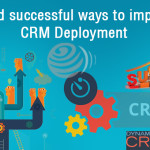Nowadays we see highly developed enterprise CRM solutions especially designed for more complex, large businesses with more departments having direct conversation with customers. This comprises of complex databases with substantial client interactions history.
Unique enterprise CRM solutions allow adding multiple teams to one department or may even add multiple sales departments. The internal workflow of the enterprise is also different than what you see at small and medium sized companies. Thus enterprise CRM solutions must offer features that give direct access to all the employees’ data, ensuring each departments from management to logistics have given their consent on the same.
With the presence of lot many offerings, it often happens that businesses get lost and this way choosing the best enterprise CRM solution tend to be a crucial task. At the same time, keep in mind that not all CRM implementations end with positive results as business fail to pay enough attention to the procedure of finalizing upon the software. For instance, in the case of enterprises, deployment of CRM needs a lot of consideration. This comprehensive structure process comprise of en evaluation and procurement sequence and thus it’s difficult for business to come up with a formal procedure to choose the online CRM that decreases the chances of wrong system implementation, speeding up the adoption process for the employees.
Here we talk about the 5 steps that ensure the core aspects are considered:
Interview employees and stakeholders
Input from prospective end users hold utmost importance to the CRM evaluation process. As sales, marketing and service people are responsible for customer interaction, they very well know what tools are going to be helpful in streamlining this process. After employees’ interview, it’s vital to discuss the CRM implementation with stakeholders as statistics shows that online CRMs rolled out sans top management approval failed. Thus those responsible for deployment must touch base with stakeholders at every step of the selection process.
Analyze input and create a list of requirements
After collecting the required information, it’s time to analyze it. As you plan on presenting this information to the top management, it’s advised to create a working summary document with structured and prioritized materials helping to form a list of requirements to vendor.
Develop a vendor ranking system
Once you’ve created a list of requirements, it’s time to organize this data in a manner that employees rank each vendor’s ability so that tech needs are met. This is helpful in choosing a vendor as per the aforesaid functionality and the online CRM’s ability to deal with particular needs instead of generalized tools.
Schedule presentations
It’s vital that potential vendor’s sales representative understands business’ functional areas as well as industry’s specificity. Vendor is required to fully demonstrate their solution’s capabilities and how they can help enterprises with the most crucial task of generating revenue.
Choose the CRM software
Post the process of interviewing, evaluation and discussions, you need to take care of few other aspects such as pricing negotiations. For instance, at times the enterprise CRM packages feature a striking price tag. But you can always negotiate by discussing the terms with vendor’s representative reaching an agreement favorable for both CRM provider and enterprise.
As it comes to selecting the best CRM solution, it is advised that you go through the formal process of selection as that helps in avoiding common pitfalls leading to the selection of wrong product.

